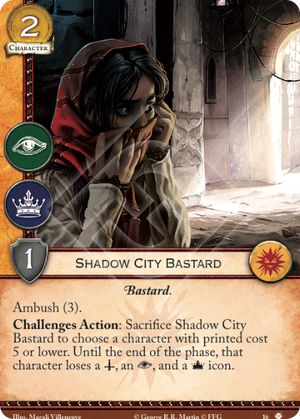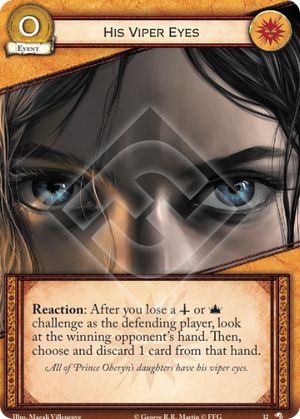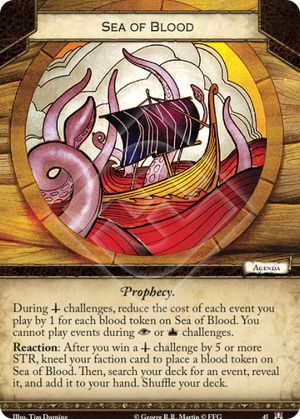Time for Martell’s most important cards to be listed and explained. For a more in-depth explanation of the point of this article, check here.
The opening out of the way, it’s time to look at Martell’s Sundamentals:
Plots:
1x At Prince Doran’s Behest
1x Marched to the Wall
Characters:
1x Areo Hotah
2x Arianne Martell
3x Desert Raider
3x Greenblood Trader
3x Shadow City Bastard
Attachments:
(None)
Locations:
3x Dorne
3x Flea Bottom
Events:
2x His Viper Eyes
Before going into specific card choices, it’s worth evaluating Martell on a macro level. Martell as a faction do not lend themselves too neatly to ‘GoodStuff’ lists, because they are often playing a more attritional game. This means the cards you include tend to be pushing a more esoteric theme, potentially stalling the opponent while your plots do the work or you wait until a point where you can utilise an event like Doran’s Game to push for the win. Consequently, many of the cards on this list are more general ‘building block’ cards, with several more efficient inclusions left out for fear they won’t fit into your specific strategy.
That said, I have made a couple of assumptions here, most notably with the restricted card. This may be controversial as Martell have their “used plot” theme served very well by the also-restricted The Wars to Come, and a Martell Wars deck made the top 8 at Worlds with a couple more making the extended cut at Stahleck. However, for Martell I simply believe Flea Bottom is THAT good that it should be your default include. You may well cut it for a different restricted, but that should be a choice you are making consciously – “I feel [restricted card x, probably Wars] is more important for this deck than Flea Bottom”. This basically comes down to the sheer number of “enters play” effects Martell have, although it’s also important for them to oppose as many challenges as possible and to make as many annoying chump challenges as possible. Thankfully Flea Bottom helps with all of this at once. With that out of the way we can look at the rest of the cards.
Firstly, the plots. At Prince Doran’s Behest is the best plot in the game. It’s a statement I’ve made several times before and one I will stand by, because it’s whatever plot you want to have, given the opponent’s plot. It also adds an extra plot in your used pile, which is something many Martell decks crave. The only downsides are losing initiative (which pretty much any deck can afford to do for one round) and having the effective size of your plot deck ‘shrink’ to 6, and to this latter point often a Martell plot deck is trying to hit redundancy with its plot effects in the first place, making this an actively good thing. Even when it isn’t, I still value that upside more.
The other plot, Marched to the Wall, is maybe an overly-specific inclusion – except that with 3x Flea Bottom, you will basically always have a point you’re happy to play it, and with so many Martell decks playing attritionally, it can be an important tool to get characters off the table. It has consistently been one of the very best plots in the entire game since the core set, and Martell can leverage it just about the best of any faction.
For non-characters, as well as the aforementioned Flea Bottom we also have Dorne and His Viper Eyes. The former is an expensive tempo hit, but despite that it’s good enough that I think that, by default, it should be in any Martell deck. It puts the opponent in an impossible position on every challenge: do they give you more options – and not just an extra card but the best of two – or do they let you win the challenge? On attack and defence it’s nightmarish to play against, and while there is a tempo hit, the fact that it reduces the blow of losing challenges means that you often don’t even mind that.
His Viper Eyes is a card that has gone in and out of decks since its release. However, I’ve always been on the side of thinking it warrants a place, and particularly so now. Firstly, Dorne means Martell have one of the best card advantage engines in the game, so a one-for-one attritional trade favours them more often than not; secondly, it’s not just a one-for-one trade, you’re getting to take out whatever you perceive the most important card in their hand to be while also getting knowledge of the rest of the cards in there; and thirdly, with Sea of Blood currently a strong force in the meta, having an event that says once the opponent fetches an event you can immediately snipe it from their hand before they get a chance to play it is really good. The only time HVE will sit dormant is if you aren’t losing military or power challenges on defence – and usually that means you’re winning.
Missing from the locations are numerous options like Starfall, Ghaston Grey and all the economy cards. This is because they can vary from deck to deck, especially economy where sometimes you’ll need the reserve of Summer Sea Port, sometimes you’ll need the pure efficiency of Dornish Fiefdom, sometimes you’ll want the reduction of Blood Orange Grove but won’t for a shadows deck, sometimes you’ll have enough costly non-characters to justify The Water Gardens and sometimes you won’t, and so on. I have also left out Venomous Blade, a common tool, as some Martell decks don’t care so much about the attritional angle and it can be quite expensive. It is nonetheless still a common include though.
Finally I need to once again explain my not including those “auto-includes”, Nightmares and The Hand’s Judgment – I promise they’ll actually be in these lists at some point! Hand’s Judgement is competing with Someone Always Tells and, to a lesser extent, He Calls It Thinking, as well as the pre-emptive strike of His Viper Eyes (which importantly is always free). Nightmares is great for soft-controlling threats on the board, but… Martell are already great at doing that. Sometimes they’ll want the redundancy, but other times they’ll need to keep the event slots free for stuff that they otherwise can’t do.
On to characters, and the most striking thing about my selection is we have three different 2 gold characters, all deemed mandatory 3x auto-includes. The oldest, Greenblood Trader, is actually the inspiration for this entire article series. I played against former Blackwater champion Darren Hazelden’s Martell deck about 9 or 10 months ago, and he was struggling seriously for card advantage the whole game. Afterwards, we realised he’d forgotten to include Greenblood Traders in his deck because he’s a moron, and the idea was planted in my mind of “what are the cards one should include by default to stop you forgetting them?” So thanks Darren, and thanks Greenblood Trader – you’re obviously amazing and belong everywhere you can go. (The Trader, not Darren.) I’ve actually witnessed some Martell players cutting the Traders of late, with card advantage from Dorne, Secret Schemes and the plotdeck seeing them through – however, I cannot condone that. In such a low-stakes slot as a 2g character, why wouldn’t you run this?
Next we have Shadow City Bastard. Simply put, if you’re running Flea Bottom, you’re running her. The ability to, round after round, completely remove the icons from a character for 1 gold is just too strong to ignore. Even if you’re not running Flea Bottom she’s still great, with a low price tag, 2 icons and a fantastic effect.
The third and most recent is Desert Raider, which has rapidly become my least favourite card to play against in the whole game because of how obscenely strong it is. It makes a mockery of military claim, removes icons, and can gain icons itself? And it’s non-unique? Ban this sick filth, and play it in the meantime. Yes it puts a power on a character, but in the first place most characters are transient enough that the power won’t still be there come the end of the game, particularly when we’re talking about Martell games, and in the second place you can even turn this negative into a positive by sniping the character with Varys DITD. Originally Bastard Daughter was in this list, but Desert Raider supersedes it – often you will run both, but I can’t imagine running the Daughter ahead of the Raider.
Next up on the cost curve we have Areo Hotah. Now, it is worth pointing out here that there is another strong version of Hotah, Areo Hotah SOD. As that one is 4 gold and relies on a large used plot pile, whereas this one is 3 gold and has a strong enters play effect, there’s a relatively clear divide in my mind – 3g Areo with Flea Bottom; 4g Areo with Wars. If neither, probably 3g Areo gets preference, simply for having such an impactful effect. This is good for Martell in pushing through a key challenge, getting unopposed, or simply negating a challenge thrown at it, and the fact that you get a 5 STR body out of it afterwards is another tilt of the scales in core Hotah’s favour.
Lastly, Arianne Martell. Again there is another version of her that’s not to be sniffed at, Arianne Martell JTO, but Core Arianne remains Martell’s best character to such a degree that most Martell character bases are still practically designed around her. You will almost always have a plethora of characters in your deck in the 3-5g range, and/or with higher Ambush costs, that are great to drop in as a surprise. For enters play effects we have the aforementioned Areo Hotah as well as the likes of Southron Messenger and Dornish Spy (the latter of which very nearly made this list). Additionally you have strong midrange bodies that are great for surprise characters for challenges like Myrcella Baratheon, Darkstar, The Bastard of Godsgrace and Nymeria Sand. You even have the ability to put in claimsoak like the ever-triggerable Greenblood Trader, Bastard Daughter or Obella Sand. Lastly there’s simply the value in getting Arianne off the board before a Valar, ready to be redeployed. Some higher-curve decks may favour the 7g body due to both her offering an attritional angle you may lack and their reduced proclivity for running mid-range targets; however, your standard-issue Martell deck will definitely want to not just include Core Arianne, but build around her.
I’d like to conclude this article by noting something interesting about this list – every single one of these cards is in an evergreen product rather than in a cycle, with the sole exception of Flea Bottom. It looks like going forward the strong core of a Martell deck is going to be set up for the long-term. Scary for the rest of us!
Thanks for reading, and as ever please comment below if you have any thoughts, suggestions or tweaks for the list.




































Not including Bastard Daughter is a sin against the Seven. There’s hardly a better card for an attrition based strategy.